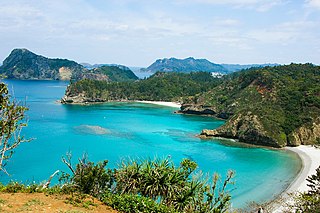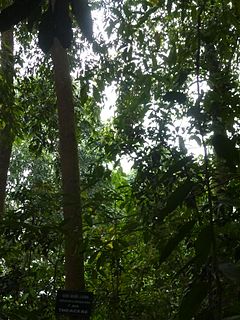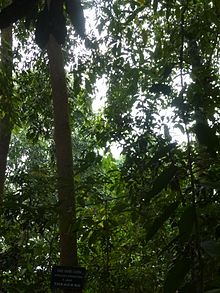
The Ogasawara subtropical moist forests is a terrestrial ecoregion which encompasses the Ogasawara Archipelago of Japan. The Ogasawara Archipelago lies in the Pacific Ocean south of Honshu, Japan's largest island, and north of the Marianas Islands. The ecoregion includes the Bonin Islands and Volcano Islands chains. The islands are volcanic in origin, and have never been linked to a continent. They are home to distinct plants and animals including many endemic species.

A genet is a member of the genus Genetta, which consists of 14 to 17 species of small African carnivorans. The common genet is the only genet present in Europe and occurs in the Iberian Peninsula and France.
This timeline of extinctions is an historical account of species that have become extinct during the time that modern humans have occupied the Earth.
Bauhinia integerrima is a species of plant in the family Fabaceae, in Brazil. The plant is endemic to southern Bahia state, in the Atlantic Forest ecoregion of Southeast Brazil.

Archidendron bigeminum is a tree species in the legume family (Fabaceae). It is found in India and Sri Lanka. It is known as "Kalitiya - කලටිය" in Sinhala people.
Adinandra angulata is a species of plant in the Pentaphylacaceae family. It is a tree endemic to Peninsular Malaysia.

Adinandra is a genus of plant in the family Pentaphylacaceae. It contains the following species:
Adinandra forbesii is a species of plant in the Pentaphylacaceae family. It is endemic to New Guinea island, within the nation of Papua New Guinea, and in the Western New Guinea region of Indonesia. It is an IUCN Red List near-threatened species, endangered by habitat loss.
Adinandra griffithii is a species of plant in the Pentaphylacaceae family.
Adinandra parvifolia is a species of plant in the Pentaphylacaceae family. It is a tree endemic to Peninsular Malaysia. It is threatened by habitat loss.
Helicia albiflora is a species of plant in the family Proteaceae. It is endemic to Papua New Guinea. It is threatened by habitat loss.
Helicia calocoma is a species of plant in the family Proteaceae. It is endemic to Papua New Guinea. It is threatened by habitat loss.
Helicia insularis is a species of plant in the family Proteaceae. It is endemic to Papua New Guinea. It is threatened by habitat loss.
Helicia neglecta is a species of plant in the family Proteaceae. It is endemic to Papua New Guinea. It is threatened by habitat loss.
Helicia peltata is a species of plant in the family Proteaceae. It is endemic to Papua New Guinea. It is threatened by habitat loss.
Kermadecia pronyensis is a species of plant in the family Proteaceae. It is endemic to New Caledonia. It is threatened by habitat loss.
Stenocarpus villosus is a species of plant in the family Proteaceae. It is endemic to New Caledonia. It is threatened by habitat loss.
As of July 2016, the International Union for Conservation of Nature (IUCN) lists 238 conservation dependent species. 0.29% of all evaluated species are listed as conservation dependent. The IUCN also lists seven subspecies and five varieties as conservation dependent.

The World's 25 Most Endangered Primates is a list of highly endangered primate species selected and published by the International Union for Conservation of Nature Species Survival Commission Primate Specialist Group, the International Primatological Society (IPS), and Conservation International (CI). The 2012–2014 list added the Bristol Conservation and Science Foundation (BCSF) to the list of publishers. The IUCN/SSC PSG worked with CI to start the list in 2000, but in 2002, during the 19th Congress of the International Primatological Society, primatologists reviewed and debated the list, resulting in the 2002–2004 revision and the endorsement of the IPS. The publication has since been a joint project between the three conservation organizations and has been revised every two years following the biannual Congress of the IPS. Starting with the 2004–2006 report, the title changed to "Primates in Peril: The World's 25 Most Endangered Primates". That same year, the list began to provide information about each species, including their conservation status and the threats they face in the wild. The species text is written in collaboration with experts from the field, with 60 people contributing to the 2006–2008 report and 85 people contributing to the 2008–2010 report. The 2004–2006 and 2006–2008 reports were published in the IUCN/SSC PSG journal Primate Conservation, while the 2008–2010 and 2010-2012 report were published as independent publications by all three contributing organizations.






